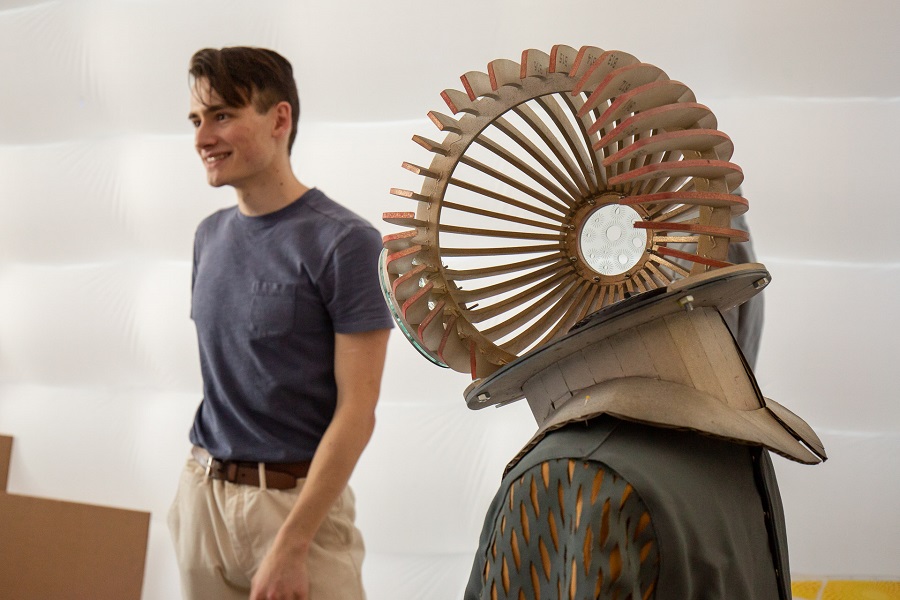
IDeATe Students Navigate Obstacles of Remote Learning
By Kathryn Reilly
This article is the second in a series that is exploring the importance of documentation practices in collaborative coursework. Read the previous piece on ideate.cmu.edu.
While the university has forged ahead with online instruction during the coronavirus pandemic, students working on physical projects and group work have had to devise new approaches to learning. Limited access to materials and technology as well as an abrupt halt in face-to-face communication has drastically shifted both students’ and professors’ expectations. Despite the uncharted conditions COVID-19 poses, IDeATe students in all majors have not given up hope in successfully completing final projects and achieving their educational ambitions.
Miranda Luong, a junior in the School of Design and Physical Computing, noted that professors have made changes to account for both limited access to resources and the physical and mental toll of the pandemic. “A lot of my professors have changed the submission requirements and made them a lot less taxing for us, knowing that the transition could be quite hard for us,” said Luong.
Because students no longer have access to studio spaces and materials on campus, Luong’s communication design studio class is no longer producing any physical projects. All final design projects will be completed and submitted digitally.
Luong is not alone in making this adjustment. Alex Lin, a senior in the School of Architecture and Intelligent Environments, has also drastically adapted the form and focus of his final projects. “Not having access to laser cutting and other digital fabrication facilities is really changing the scope of my work,” said Lin. Students have dispersed to spend quarantine in diverse locations across the globe. Facing the additional obstacle of time zone differences, Lin also has to manage a group project with team members whose schedules are six hours ahead.
In addition to making necessary modifications to course requirements, professors have swiftly responded to constraints posed by remote learning in order to reach their intended educational goals. “Our teacher has been working tirelessly to get Arduinos and all of the digital tools that we would need to learn the skills that we were intended to get from the course,” said Lin who is taking Responsive Structures taught by Susan Finger. “She has gone above and beyond to continue the trajectory of the class's content.”
Students have been making the most of collaboration tools, integrating a combination of products already in their workflow with new applications that enhance remote learning. Steve Chabassol, a BHA student with a Creative Writing and Music Technology major and an IDeATe minor in Sound Design, has found that shifting from paper critiques to a shared Google Drive folder has allowed him to quickly document feedback. “Poetry workshops are usually pretty old-school, you bring in printed copies of your work and other students write on them and then give them back to you,” said Chabassol of the typical process. The poetry workshop now stores drafts in a shared course folder on Google Drive.
Remote learning requires that students in group projects hit key deadlines without the benefits of typical face-to-face meetings. Luong has considered introducing project management software to keep her team on the same page. “It's much more important for people to stay on track, so we have considered using Trello, a task management platform,” said Luong. Software tools that enhance group communication have become a proxy to scheduled group check-ins.
Shifting projects to digital methods has also influenced students’ usual documentation practices. “I realized that I'm no longer using my sketchbook as much or writing notes down physically,” said Luong now finding herself prone to typing notes. Luong has also been using the collaborative user experience modeling tool, Figma, to work on sketches with other students.
“It's been a great way for us to compile a mood board and as well as look at things in the same way as sharing a screen,” said Luong.
Despite their efforts to maintain progress, students have experienced strain on the production and documentation process. “I'm having more difficulty matching the documentation level that's possible for a lot of other projects that I've done in the past,” said Lin. Along with other students, Lin has gotten creative in documenting projects with the materials he has at hand and remains hopeful for projects he will continue digitally.
Continuing to add examples of creative work to portfolios is an important goal for many IDeATe students. “I'm hoping that the projects I create can live on its own and not be so obviously tied to the situation that I was in when I was producing,” said Miranda Luong.
With aspirations to deliver a final business plan for a non-profit, Steve Chabassol will complete his capstone project this semester. A valuable component of his research and final deliverable is connecting with people for interviews which he originally conducted face-to-face. Chabassol expressed uneasiness with asking for peoples’ time in a period of crisis.
While we wrestle with the distress and uncertainty of the pandemic, bright spots of innovation continue to emerge from IDeATe community. Each of these students demonstrate their own initiative to maintain progress towards their initial goals, however realizing that the pandemic has imposed substantial hindrances.
In a follow-up piece, Reilly will report on IDeATe professors whose quick strides to convert class to online instruction have made remote learning possible.